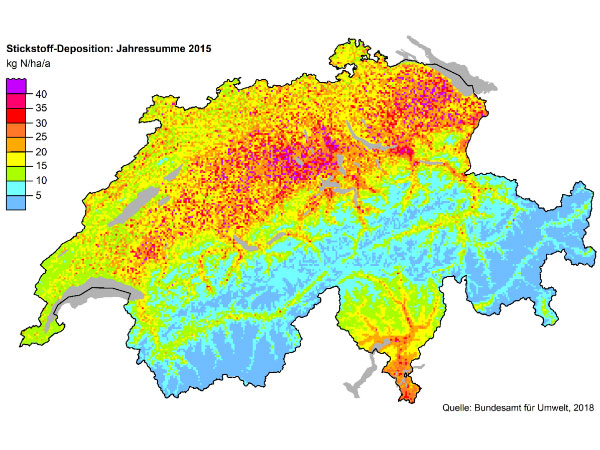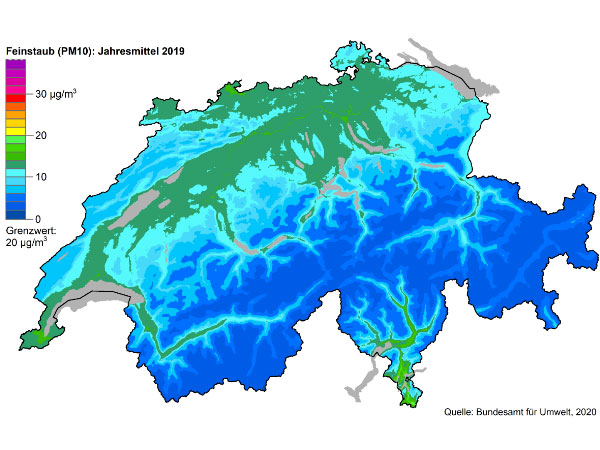Politics / Datasets in Switzerland

and promote biodiversity.
So far, the federal and cantonal governments have spent over CHF 100 million net on measures to reduce ammonia emissions. Most of it was used in agriculture. The result is that Switzerland has reduced about 4’500 tons of ammonia emissions annually compared to the reference year 1990. The goal of the Swiss government is to save more than 30’000 tons of ammonia emissions per year.
With the current ammonia emissions (NH3) of approx. 60’000 tons per year, our state
Switzerland's internationally binding reduction target from the Kyoto Protocol is also contained in the CO2 Act at national level. This states that greenhouse gas emissions in 2030 may not exceed 50% of the greenhouse gas emissions in the reference year 1990. On average for the years 2021–2030, greenhouse gas emissions must be reduced by at least 35% compared to 1990 levels.
What ammonia causes in terms of costs

The hidden costs of ecosystem damage, i.e. environmental damage of a different kind, can be calculated at around CHF 10’000.00 per ton of ammonia gas emitted. It is known, for example, that around 1/3 of the forest areas and poor meadows or all raised bogs and fens are bed-dried and damaged due to critical ammonia loads.
Fertilization / process in the soil
Basically, it can be said that nutrients in acidified slurry are absorbed by plants faster and with better quality. There is a simple reason for this: plant roots can absorb nitrogen in the form of urea, ammonium or nitrate. Due to the rapid conversion of ammonia and urea into ammonium (which is generated during our processing), plants usually absorb nitrogen in the form of ammonium after application.
This so-called “active uptake” has the advantage that the plants only absorb as much nitrogen as they need in their maturity stage.
The plant population can thus control the amount of nitrogen absorbed and thus i. e. produce the right strength on cell walls and at the same time significantly increase their N fertilizer exploitation. Nutrient supply, growth and yield of grassland and arable crops are positively influenced by the correct fertilization with acidified slurry. In addition, the acidified slurry offers the advantage that, due to its better absorption by the plants – generated by the interaction of sulfur sulphate – the amounts of water-soluble nitrogen and water-soluble phosphorus in the seepage water decrease. Ammonium is a positively charged form of nitrogen. As a result, ammonium is well bound to soil particles and thus cannot be washed off and get into the groundwater. Thus, it can rightly be said that the eutrophication of certain water rivers and lakes – with the fertilization of acidified slurry – could be reduced. The uptake of sulfur sulfate by the plants runs parallel to the uptake of nitrogen.
The acid introduced into the soil is buffered by it and can – not necessarily – lead to a slight decrease in the acid neutralization capacity (ANC) of the soil. This capacity would essentially be caused by long-term S over-fertilization and is therefore primarily influenced by farm-specific site factors, the soil buffer capacity and the entire farm fertilization strategy itself. Fertilization with acidified slurry by using H2SO4 should be adapted to the soil and to S requirements of the respective crops and tends to require additional mineral fertilizers without S. This is another way to achieve a positive ANC balance in our soils. The losses of ANC, which would be caused by over-fertilization with sulfur, could be compensated by liming (about 3 kg CaCO3 per kg S*[0.065 kmol]).
Acidification of slurry leads to the dissolution of phosphates such as struvite and carbonates, reducing P, Ca and Mg deposition. Furthermore, acid supplies the soil with additional easily soluble hydrogen ions (H+) and other weak acids are protonated. The nutrients in the processed slurry are therefore in a balanced ratio to each other. The soil thus has a higher cation exchange capacity (CEC) and a lower anion exchange capacity (AEC), which ultimately leads to a long-term healthy soil that can work better and more efficiently.
It should be remembered that the acidified slurry has positive effects on the plant availability of the elements Ntot, P, K, Ca, Mg and SO4 (referred to as the “fourth macro-element”), as these increase after the treated slurry has been applied. The risk of leaching of the elements mentioned is low and purely dependent on rain. Low because the acidified slurry has an increased N mineralization and it is applied analogously to the weather conditions of foliar fertilization and not, as usual, shortly before precipitation. In addition, the doses of acidified slurry should be adjusted to the growth of the plants and their demand for S, which is usually more the case in spring than in autumn.
It should also be considered that the pH value of our soils is not influenced in the long term by acidified slurry (neither down nor up) and that after a maximum of 70 days after the application of acidified slurry, this value is back to the level as before application. The consumption of lime will therefore not be able to increase with acidified slurry. This knowledge is clearly underlined by the fact that the soil acidity is neither in the measurement of the normal pH value – i.e. an aqueous suspension (pH) – nor in the measurement of the pH value under natural conditions – i.e. with an exchange of potassium chloride cations (pHKCl) – changed.




